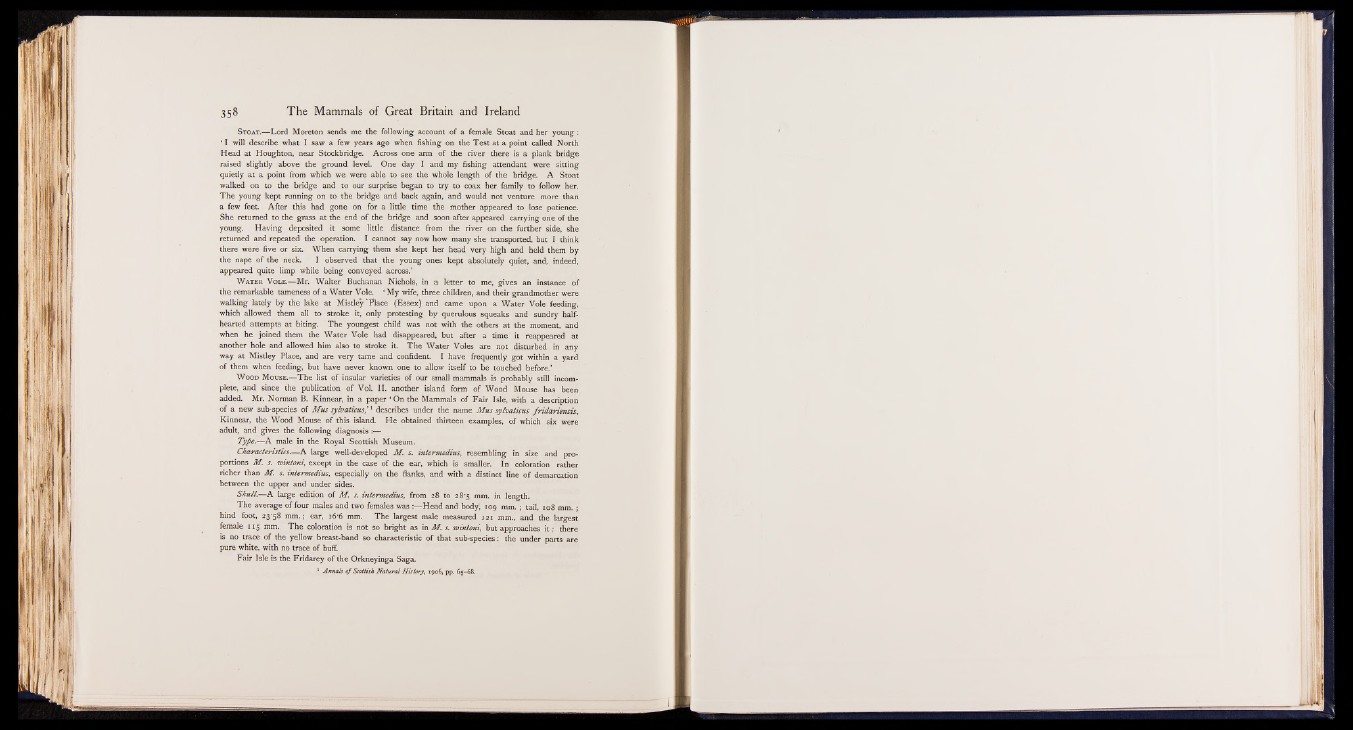
S toa t .— Lord Moreton sends me the following account o f a female Stoat and her yo u n g :
‘ I will describe what I saw a few years ago when fishing on the T es t at a point called North
Head at Houghton, near Stockbridge. Across one arm o f the river there is a plank bridge
raised slightly above the ground level. One day I and my fishing attendant were sitting
quietly at a point from which we were able to see the whole length o f the bridge. A Stoat
walked on to the bridge and to our surprise began to try to coax her family to follow her.
T he young kept running on to the bridge and back again, and would not venture more than
a few feet. After this had gone on for a little time the mother appeared to lose patience.
She returned to the grass at the end o f the bridge and soon after appeared carrying one o f the
young. Having deposited it some little distance from the river on the further side, she
returned and repeated the operation. I cannot say now how many she transported, but I think
there were five or six. When carrying them she kept her head very high and held them by
the nape o f the neck. I observed that the young ones kept absolutely quiet, and, indeed,
appeared quite limp while being. conveyed across.’
W a t er V ole.— Mr. Walter Buchanan Nichols, in a letter to me, gives an instance o f
the remarkable tameness o f a Water Vole. ‘ M y wife, three children, and their grandmother were
walking lately by the lake at Mistley 'Place (Essex) and came upon a Water Vole feeding,
which allowed them all to stroke it, only protesting by querulous squeaks and sundry halfhearted
attempts at biting. T he youngest child was not with the others at the moment, and
when he joined them the Water Vole had disappeared, but after a time it reappeared at
another hole and allowed him also to stroke it. T h e Water Voles are not disturbed in any
way at Mistley Place, and are very tame and confident I have frequently got within a yard
o f them when feeding, but have never known one to allow itself to be touched before.’
W ood M ouse.— T he list o f insular varieties o f our small mammals is probably still incomplete,
and since the publication o f Vol. II. another island form o f Wood Mouse has been
added. Mr. Norman B. Kinnear, in a paper ‘ On the Mammals o f Fair Isle, with a description
o f a new sub-species o f M us sylvaticus,’ 1 describes under the name M us sylvaticus frid a rien sis,
Kinnear, the Wood Mouse o f this island. H e obtained thirteen examples, o f which six were
adult, and gives the following d ia g n o s is^ ^ ^ i
Type.— A male in the Royal Scottish Museum.
Characteristics— A large well-developed M . s. intermedins, resembling in size and proportions
M . s. wintoni, except in the case o f the ear, which is smaller. In coloration rather
richer than M . s. intermedins, especially on the flanks, and with a distinct line o f demarcation
between the upper and under sides.
S k u ll.— A large edition o f M . s. intermedins, from 28 to 28‘5 mm. in length.
The average o f four males and two females was :— Head and body; 109 mm. ; tail, 108 mm. ;
hind foot, 23^58 mm.; ear, i6 -6 mm. T he largest male measured 121 mm., and the largest
female 115 mm. T he coloration is not so bright as in M . s. wintoni, but approaches it ; there
is no trace o f the yellow breast-band so characteristic o f that sub-species: the under parts are
pure white, with no trace o f buff.
Fair Isle is the Fridarey o f the Orkneyinga Saga.
1 Annals o f Scottish Natural History, 1906, pp. 65-68.